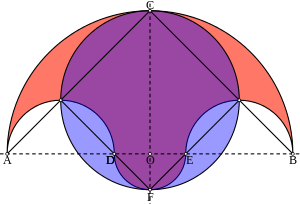Salinon

The salinon (meaning "salt-cellar" in Greek) is a geometrical figure that consists of four semicircles. It was first introduced in the Book of Lemmas, a work attributed to Archimedes.[1]
Construction
Let O be the origin on a Cartesian plane. Let A, D, E, and B be four points on a line, in that order, with O bisecting line AB. Let AD = EB. Semicircles are drawn above line AB with diameters AB, AD, and EB, and another semicircle is drawn below with diameter DE. A salinon is the figure bounded by these four semicircles.[2]
Properties
Area
Archimedes introduced the salinon in his Book of Lemmas by applying Book II, Proposition 10 of Euclid's Elements. Archimedes noted that "the area of the figure bounded by the circumferences of all the semicircles [is] equal to the area of the circle on CF as diameter."[3]
Namely, the area of the salinon is:
Proof
Let the radius of the midpoint of AD and EB be denoted as G and H, respectively. Therefore, AG = GD = EH = HB = r1. Because DO, OF, and OE are all radii to the same semicircle, DO = OF = OE = r2. By segment addition, AG + GD + DO = OE + EH + HB = 2r1 + r2. Since AB is the diameter of the salinon, CF is the line of symmetry. Because they all are radii of the same semicircle, AO = BO = CO = 2r1 + r2.
Let P be the center of the large circle. Because CO = 2r1 + r2 and OF = r2, CF = 2r1 + 2r2. Therefore, the radius of the circle is r1 + r2. The area of the circle = π(r1 + r2)2.
Let x = r1 and y = r2. The area of the semicircle with diameter AB is:
- .
The area of the semicircle with diameter DE is:
The area of each of the semicircles with diameters AD and EB is
Therefore, the area of the salinon is:
Q.E.D.[4]
Arbelos
Should points D and E converge with O, it would form an arbelos, another one of Archimedes' creations, with symmetry along the y-axis.[3]
See also
References
- 1 2 Weisstein, Eric W. ""Salinon." From MathWorld--A Wolfram Web Resource". Retrieved 2008-04-14.
- ↑ Nelsen, Roger B. (2002). "Proof Without Words: The Area of a Salinon". Mathematics Magazine (PDF). p. 130.
- 1 2 Bogomolny, A. "Salinon: From Archimedes' Book of Lemmas from Interactive Mathematics Miscellany and Puzzles". from Interactive Mathematics Miscellany and Puzzles. Retrieved 2008-04-15.
- ↑ Umberger, Shannon. "Essay # 4 - The Arbelos and the Salinon". Retrieved 2008-04-18.
External links
L’arbelos. Partie II by Hamza Khelif at www.images.math.cnrs.fr of CNRS